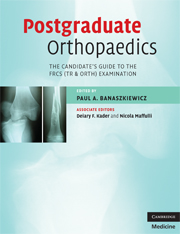Book contents
- Frontmatter
- Contents
- List of contributors
- Foreword by Mr Peter Gibson
- Preface
- Glossary
- Section 1 The FRCS (Tr & Orth) examination
- Section 2 The written paper
- Section 3 The clininicals
- 3 The short cases
- 4 Short case list
- 5 The long cases
- 6 Long case list
- 7 Hand and wrist clinical cases
- 8 Shoulder and elbow clinical cases
- 9 Spine clinical cases
- 10 Hip clinical cases
- 11 Knee clinical cases
- 12 Foot and ankle clinical cases
- 13 Paediatric clinical cases
- Section 4 Adult elective orthopaedics oral
- Section 5 The hand oral
- Section 6 The paediatric oral
- Section 7 The trauma oral
- Section 8 The basic science oral
- Section 9 Miscellaneous topics
- Index
11 - Knee clinical cases
from Section 3 - The clininicals
Published online by Cambridge University Press: 22 August 2009
- Frontmatter
- Contents
- List of contributors
- Foreword by Mr Peter Gibson
- Preface
- Glossary
- Section 1 The FRCS (Tr & Orth) examination
- Section 2 The written paper
- Section 3 The clininicals
- 3 The short cases
- 4 Short case list
- 5 The long cases
- 6 Long case list
- 7 Hand and wrist clinical cases
- 8 Shoulder and elbow clinical cases
- 9 Spine clinical cases
- 10 Hip clinical cases
- 11 Knee clinical cases
- 12 Foot and ankle clinical cases
- 13 Paediatric clinical cases
- Section 4 Adult elective orthopaedics oral
- Section 5 The hand oral
- Section 6 The paediatric oral
- Section 7 The trauma oral
- Section 8 The basic science oral
- Section 9 Miscellaneous topics
- Index
Summary
Anterior cruciate deficiency
Usually there will be one or two patients with an ACL-deficient knee in the short cases.
Memorandum
“This patient is a young, typically male, sporty type of person in shorts. They usually have obvious quadriceps wasting with possible medial and lateral arthroscopic portal scars.”
“The patient has a normal gait and knee motion, a minor effusion and no specific areas of tenderness in the knee. The anterior drawer test and Lachman's test revealed an increase in translation of the tibia on the femur compared to the opposite side and no firm end point was felt. The pivot shift test was positive for anterior cruciate deficiency (describe what you are doing as you are doing it). A pivot shift demonstrates a non-functioning ACL. With the leg extended there is an anterior subluxation of the tibia on the femur. Flexion with a valgus stress and axial load to the knee causes the anteriorly subluxed knee to spontaneously reduce into its normal position with respect to the femur with a sudden visible jump or shift at 20°–30° flexion.”
Discussion
Indications for ACL reconstruction
Technique
Pivot shift
Short case 1
Examiner: This is a 20-year-old male who sustained an injury to his right knee 1 year ago. Examine his knee for instability.
Candidate: I would normally start my examination by walking the patient.
Examiner: Don't bother, just examine on the couch.
Candidate: I mentioned quadriceps wasting. Patellar apprehension was test negative. Knee flexed to 90°, negative sag, normal step off.
The anterior drawer test was positive and there was a soft end point on Lachman's test.[…]
- Type
- Chapter
- Information
- Postgraduate OrthopaedicsThe Candidate's Guide to the FRCS (TR & Orth) Examination, pp. 105 - 109Publisher: Cambridge University PressPrint publication year: 2008



